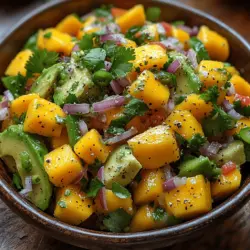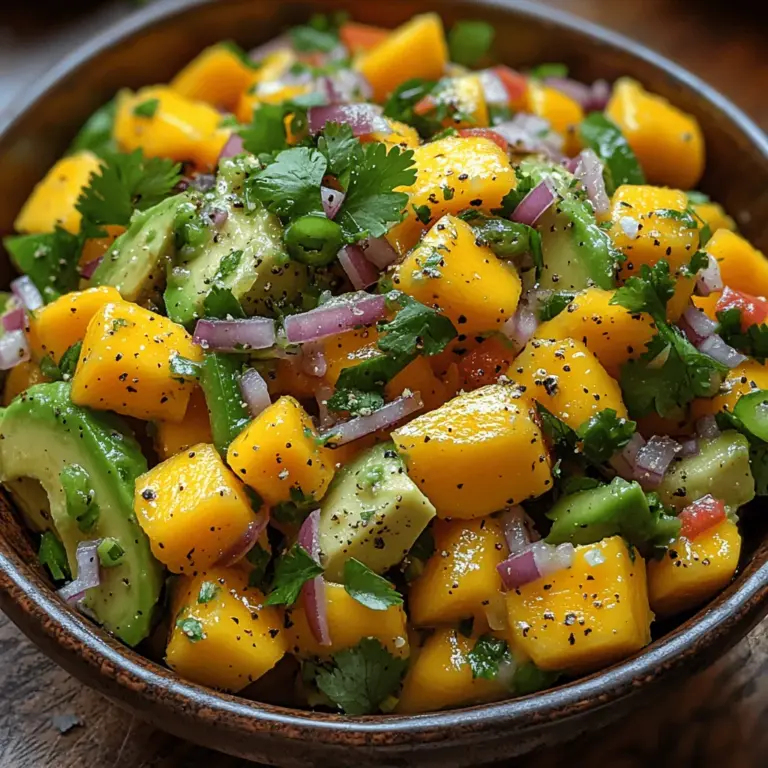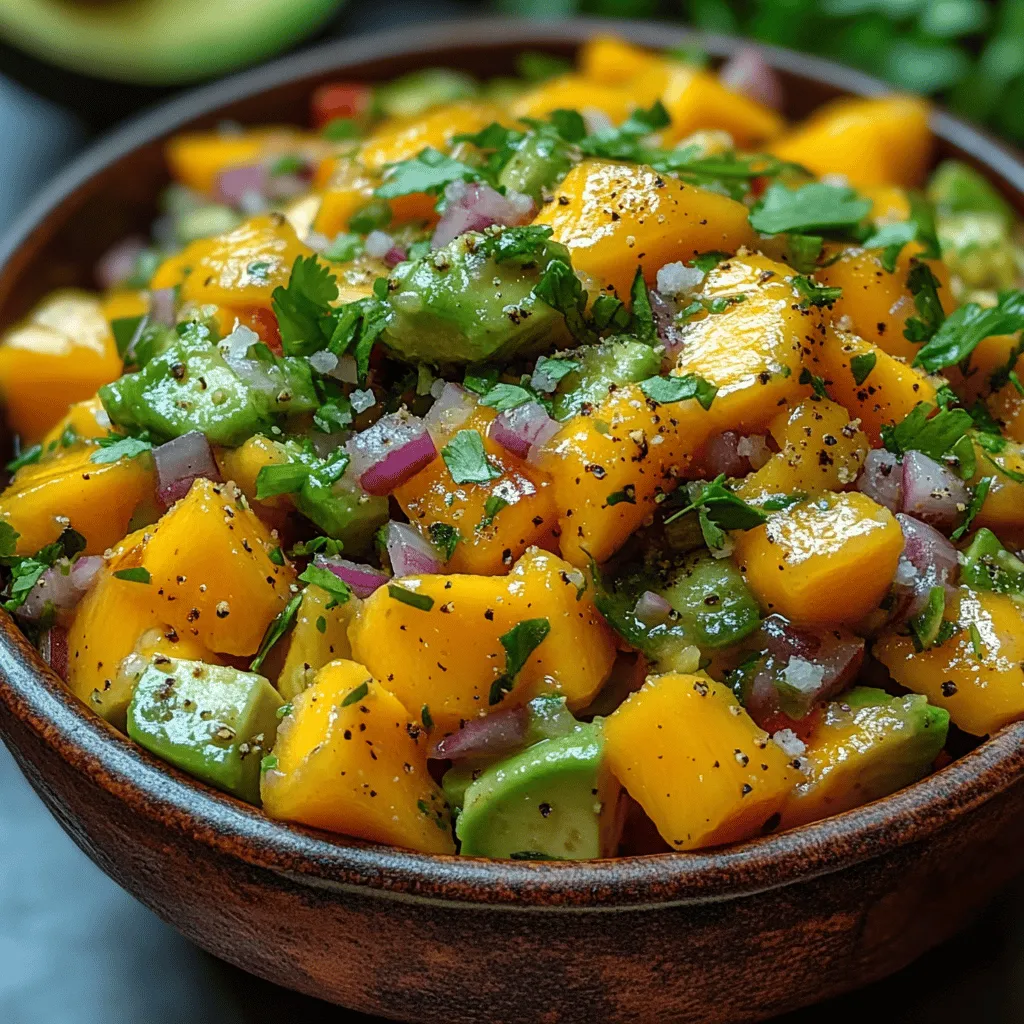Introduction
In the world of culinary delights, few dishes can rival the refreshing and vibrant combination of flavors found in mango avocado salsa. This delightful recipe is not just a side dish; it’s a celebration of fresh ingredients and bold flavors. Whether you’re hosting a summer barbecue, preparing a family dinner, or looking for a light snack, this zesty salsa can elevate your meal with its bright colors and tantalizing taste.
Mango avocado salsa is becoming increasingly popular in kitchens across the globe due to its versatility. It can serve as a dip, topping, or even a salad on its own. The luscious combination of ripe mangoes and creamy avocados offers a balance of sweetness and richness, while the addition of onions, cilantro, and lime juice provides a zesty kick that brings all the flavors together. This recipe is perfect for anyone looking to add a touch of tropical flair to their culinary repertoire, whether you are a novice cook or a seasoned chef.
This dish is particularly appealing to health-conscious individuals and those seeking gluten-free or vegan options, as it is packed with nutrients and free from animal products. Additionally, it caters to a variety of dietary preferences, making it an ideal choice for gatherings where guests may have different food restrictions.
Ingredients
To make this zesty mango avocado salsa, you’ll need a selection of fresh, high-quality ingredients. Below is a list of essential ingredients along with explanations of their roles in the recipe:
Essential Ingredients:
– Ripe Mangoes: The star of the salsa, mangoes provide natural sweetness and a juicy texture. Look for mangoes that yield slightly to pressure when gently squeezed, indicating they are ripe.
– Avocado: Avocado adds creaminess and richness to the salsa. It also contributes healthy fats that are beneficial for heart health.
– Red Onion: This ingredient adds a mild bite and crunch. Red onions are preferred for their sweetness and vibrant color, which enhances the visual appeal of the salsa.
– Fresh Cilantro: Cilantro lends a fresh, herbal note that complements the sweetness of the mango and the creaminess of the avocado.
– Lime Juice: Freshly squeezed lime juice provides acidity and brightness, balancing the richness of the avocado and enhancing the overall flavor of the salsa.
– Salt and Pepper: Basic seasonings that enhance the flavors of the ingredients. Adjust to taste.
Ingredient Roles:
Each ingredient plays a crucial role in the flavor profile and texture of the salsa. The sweetness of the mango is perfectly balanced by the tartness of the lime juice, while the avocado contributes a creamy element that makes the salsa satisfying. The red onion and cilantro add crunch and freshness, creating a harmonious blend of flavors.
Possible Substitutions:
– Mango: If mangoes are not in season, you can substitute them with diced peaches or pineapple for a different fruity twist.
– Avocado: For those allergic to avocados, try using diced cucumbers or a combination of beans for added texture and nutrition.
– Red Onion: If you prefer a milder flavor, you can substitute red onion with green onions or chives.
– Cilantro: If cilantro isn’t your favorite herb, parsley or basil can provide a different yet delightful flavor.
Preparation Steps
Now that you have gathered your ingredients, it’s time to dive into the preparation process. Follow these detailed steps to create your zesty mango avocado salsa:
Step-by-Step Preparation:
1. Prepare the Ingredients: Start by washing all your fresh produce thoroughly to remove any dirt or pesticides.
2. Dice the Mango: Cut the mango in half, avoiding the pit. Use a sharp knife to slice the flesh into cubes, then scoop them out with a spoon. Aim for uniform pieces to ensure even distribution in the salsa.
3. Chop the Avocado: Cut the avocado in half, remove the pit, and use a spoon to scoop the flesh out. Dice it into small cubes, similar in size to the mango. Be careful not to mash the avocado while dicing.
4. Finely Chop the Red Onion: Use a sharp knife to finely chop the red onion. The smaller the pieces, the less overwhelming the onion flavor will be.
5. Chop the Cilantro: Rinse the cilantro and pat it dry. Remove the leaves from the stems and chop them finely. This will ensure an even distribution of flavor.
6. Combine the Ingredients: In a large mixing bowl, gently combine the diced mango, avocado, chopped red onion, and cilantro. Be careful not to mash the avocado during this process.
7. Add Lime Juice and Seasoning: Squeeze fresh lime juice over the mixture and sprinkle with salt and pepper. Gently fold everything together until well combined. Adjust the seasoning to your preference.
Tips for Effective Preparation Techniques:
– Use a Sharp Knife: A sharp knife is essential for clean cuts, especially when dicing soft ingredients like avocado. This helps maintain the integrity of the pieces and prevents mashing.
– Timing is Key: To prevent the avocado from browning, prepare the salsa shortly before serving. If you need to prepare it in advance, add the lime juice immediately after cutting the avocado to help minimize oxidation.
Cooking Methods
While this salsa is not cooked, understanding the methods behind food preparation can enhance the flavor and texture of your dish. Here’s how the techniques used in this recipe contribute to the overall experience:
Description of the Methods:
– Chopping and Dicing: The way you chop and dice the ingredients affects not only the texture but also the flavor release. Smaller, uniform pieces allow for better mixing and a more harmonious blend of flavors in every bite.
– Mixing: Gently folding the ingredients instead of stirring vigorously helps to maintain the integrity of the avocado and mango, ensuring a delightful texture in the final dish.
Flavor and Texture Enhancement:
The combination of fresh, raw ingredients allows the natural flavors to shine through without the need for cooking. The acidity from the lime juice brightens the flavors, while the creaminess of the avocado provides a satisfying mouthfeel. The crunch from the onions adds an enjoyable contrast, making each bite a delightful experience.
Alternative Cooking Methods:
If you’re looking to experiment with flavors, consider roasting the mangoes or avocados slightly before adding them to the salsa. This can enhance their sweetness and create a deeper flavor profile. Alternatively, you can grill the ingredients to add a smoky element that complements the freshness of the salsa.
Serving Suggestions
To make your zesty mango avocado salsa truly shine, consider these serving ideas that enhance its presentation and pairings:
Plating and Presentation:
– Serve the salsa in a colorful bowl garnished with extra cilantro leaves or lime wedges for a beautiful presentation.
– For a more elegant serving option, consider using individual ramekins or small glasses, layering the salsa with tortilla chips on the side for a stunning visual effect.
Complementary Dishes:
– This salsa pairs wonderfully with grilled chicken or fish, adding a bright, fruity contrast to savory proteins.
– It can also be served alongside tortilla chips for a crunchy snack or as a topping for tacos and burritos, elevating your Mexican-inspired dishes.
Beverage Recommendations:
– To complement the tropical flavors of the salsa, consider pairing it with a refreshing beverage like a crisp white wine, a fruity sangria, or a light beer. For non-alcoholic options, a citrus-infused sparkling water or a tropical smoothie can enhance the overall dining experience.
In this article, we explored the vibrant world of zesty mango avocado salsa, from its essential ingredients to the detailed preparation steps. This recipe not only brings a burst of flavor to your plate but also offers versatility for any occasion or dietary preference. Stay tuned for the following sections, where we will delve into the nutritional information and more serving suggestions to make this dish a staple in your kitchen.
Health-Conscious Modifications
Zesty Mango Avocado Salsa is not only a delightful addition to any meal, but it can also be modified to cater to health-conscious individuals. To make this dish even healthier, consider the following adjustments:
– Reduce Sodium: If you are watching your sodium intake, use fresh lime juice and herbs instead of salt. Fresh ingredients often bring out the natural flavors without the need for added sodium.
– Add More Veggies: Incorporate additional vegetables like diced bell peppers, cucumbers, or jicama for extra crunch and nutrients. These additions can enhance the fiber content while keeping the calorie count low.
– Swap Ingredients: For a lighter version, you can substitute the avocado with a lower-calorie option like mashed steamed cauliflower or use less avocado altogether to reduce calories while maintaining a creamy texture.
Caloric Breakdown and Macronutrient Profile
Understanding the caloric breakdown and macronutrient profile of Zesty Mango Avocado Salsa can help you appreciate its nutritional benefits:
– Serving Size: Approximately 1/2 cup
– Calories: 120 calories
– Fat: 7 grams (primarily from avocado)
– Carbohydrates: 15 grams
– Fiber: 4 grams
– Protein: 2 grams
This salsa is rich in healthy fats from the avocado and packed with vitamins and minerals from fresh mangoes and vegetables. The fiber content aids digestion, making it a wholesome addition to your meals.
Cultural Significance
Zesty Mango Avocado Salsa is a dish deeply rooted in the culinary traditions of Latin America and the Caribbean. The combination of mango and avocado showcases the vibrant flavors and fresh ingredients characteristic of these regions.
Historical Context
Historically, the use of mango dates back thousands of years to South Asia, where it was cultivated for its sweetness and health benefits. Over time, as trade routes expanded, mangoes made their way to the Americas, where they were embraced and integrated into local cuisines. Avocados, native to Central Mexico, have long been a staple in Latin American diets, celebrated for their creamy texture and nutritional value. The fusion of these two ingredients in salsa not only highlights their individual flavors but also represents the blending of cultures and culinary practices.
Variations Across Regions
Across different regions, variations of mango avocado salsa can be found. For instance, in the Caribbean, it is common to add chopped cilantro and a hint of heat from jalapeños, reflecting local preferences for bold flavors. In contrast, coastal Mexican regions might incorporate fresh seafood, making it a refreshing topping for fish tacos. Each variation adds its unique twist while maintaining the essence of the original dish.
Personal Anecdotes
Every family has its version of this salsa. For many, it serves as a go-to recipe for summer barbecues or family gatherings, often passed down through generations. One of my fondest memories was preparing this dish with my grandmother on sunny afternoons. She would teach me how to select the ripest mangoes and avocados, emphasizing the importance of fresh, quality ingredients. Those moments in the kitchen, filled with laughter and stories, are what make this salsa truly special.
Common Mistakes to Avoid
When preparing Zesty Mango Avocado Salsa, there are a few common pitfalls to keep in mind to ensure the best results:
– Using Unripe Fruits: The flavor of the salsa relies heavily on the sweetness of ripe mangoes and the creaminess of perfectly ripe avocados. Opt for fruits that yield slightly when pressed to ensure they are at their peak flavor.
– Over-Mixing: While it’s important to combine ingredients well for even flavor distribution, over-mixing can turn your salsa into a mushy mess. Gently fold the ingredients together to maintain texture.
– Neglecting to Taste: Always taste your salsa before serving. The balance of flavors can vary based on the ripeness of your ingredients. Adjust lime juice, salt, or spices as needed to suit your palate.
Tips for Troubleshooting Common Issues
– Too Spicy: If your salsa turns out too spicy from the jalapeños, try adding more diced mango or avocado to balance the heat.
– Too Sour: If the salsa is overly acidic, a pinch of sugar can help mellow the flavors. Alternatively, add more diced avocado for creaminess.
– Too Chunky: If you prefer a smoother texture, consider pulsing the mixture in a food processor briefly. Ensure not to over-process to maintain some texture.
Importance of Precision and Patience
Cooking is an art that requires both precision and patience. Taking the time to select the best ingredients and allowing flavors to meld together can elevate your dish significantly. Rushing through the preparation can lead to missed opportunities for enhancing flavor.
Variations and Customizations
Zesty Mango Avocado Salsa is versatile, making it easy to customize according to dietary preferences and personal tastes:
– Spicy Mango Salsa: For those who enjoy heat, add diced jalapeños or serrano peppers. You can also incorporate a dash of hot sauce for an extra kick.
– Citrus Twist: Enhance the flavor profile by adding a mix of citrus juices, such as orange or grapefruit, in addition to lime. This creates a refreshing twist that brightens the salsa.
– Herb Variations: Instead of cilantro, consider using fresh basil or mint for a different aromatic experience. Each herb provides a unique flavor profile that can change the overall character of the salsa.
– Dietary Adaptations: This recipe is naturally vegan and gluten-free, making it suitable for various dietary needs. For those following a low-carb diet, use diced zucchini as a substitute for mango to reduce sugar content while maintaining the salsa’s freshness.
Storing and Reheating
Proper storage and reheating techniques can help maintain the freshness and flavor of your Zesty Mango Avocado Salsa:
Guidelines for Proper Storage
– Refrigeration: Store any leftover salsa in an airtight container in the refrigerator. It is best consumed within 2-3 days, as avocados can brown quickly.
– Freezing: While fresh salsa is ideal, you can freeze it if necessary. Place the salsa in a freezer-safe container, leaving room for expansion. It can last up to 3 months in the freezer, but the texture may change upon thawing.
Best Practices for Reheating
This salsa is best enjoyed fresh and does not require reheating. If stored in the freezer, thaw it overnight in the fridge before serving. Stir gently to recombine, as some separation may occur during freezing.
Shelf Life and Signs of Spoilage
Always check for signs of spoilage before consuming leftovers. If the salsa develops an off smell, changes in color, or shows mold, it is best to discard it. Freshness is key to enjoying the vibrant flavors of this dish.
Conclusion
Zesty Mango Avocado Salsa is more than just a side dish; it’s a celebration of fresh ingredients, cultural heritage, and shared experiences. The vibrant colors and flavors come together to create a salsa that is not only delicious but also versatile enough to complement a variety of meals.
Reflecting on the joy of cooking and sharing meals, this salsa embodies the spirit of gatherings, whether at casual barbecues or festive celebrations. Each scoop carries memories of laughter, love, and connection, making it a perfect addition to any occasion. As you prepare this dish, remember to savor the process and enjoy the delightful results that can brighten up your everyday meals. So gather your ingredients, invite friends or family, and create your version of this zesty salsa that is sure to become a staple in your kitchen.


